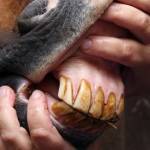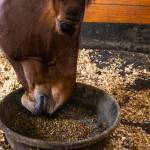Tooth Problems in Older Horses

Equine teeth erupt continuously from a horse’s gums throughout its life, but the shape and condition of the teeth change as a horse ages. Because of these factors, older horses may have dental problems not usually observed in younger equines.
Here are some facts about dental condition and management in older horses.
- Horses over the age of 15 begin to lose tooth enamel, and the chewing surface of each tooth becomes narrower as the tooth shape tapers in older horses. Chewing may be less efficient with these smaller, weaker teeth.
- Narrower teeth lead to wider interdental gaps that allow feed to become impacted between the teeth, resulting in gum inflammation. Discomfort, infection, and sinusitis often result.
- Incisors and other teeth may become loose in older horses and should be extracted to control pain as the horse eats.
- Sharp edges, wave mouth, and other conditions seen in younger horses also occur frequently in older horses. Correction should be focused on bringing as many teeth as possible into functional condition.
- Equine odontoclastic tooth resorption and hypercementosis are problems that have recently been recognized in older horses. The problems cause pain in the incisors, halitosis, overproduction of saliva, gum inflammation, and changes in behavior. The cause is not known, and extraction of the incisors may be the only effective treatment.
- If the horse has extensive dental problems or teeth have been extracted, it may be necessary to change the diet by providing soaked feeds, replacing part of the grain with fat, feeding smaller and more frequent meals, and offering some of the forage as a cubed or pelleted product that can be fed after soaking.








